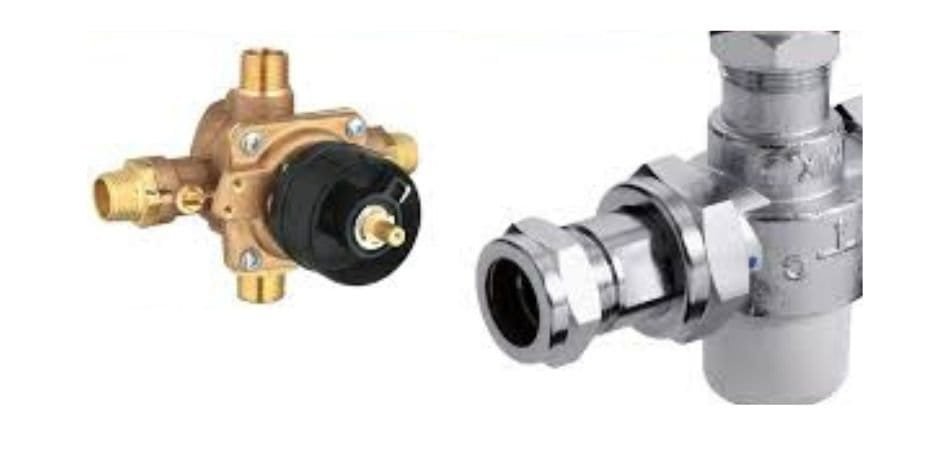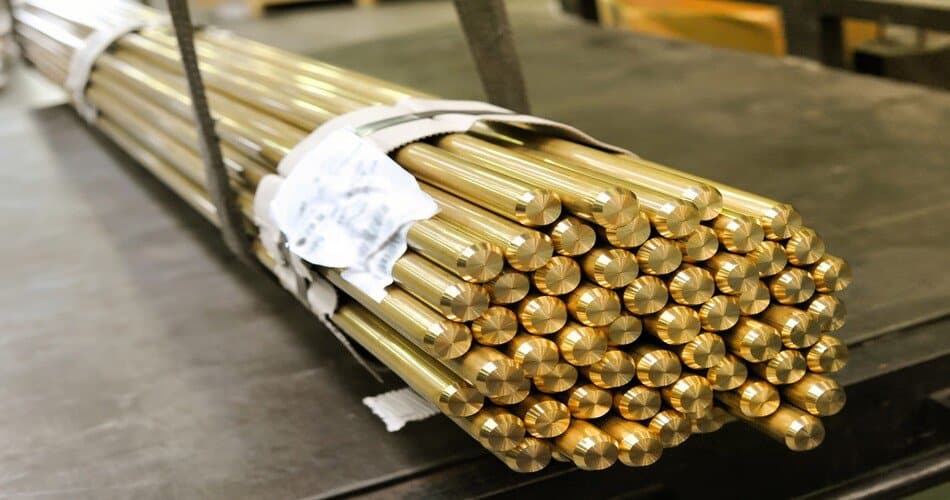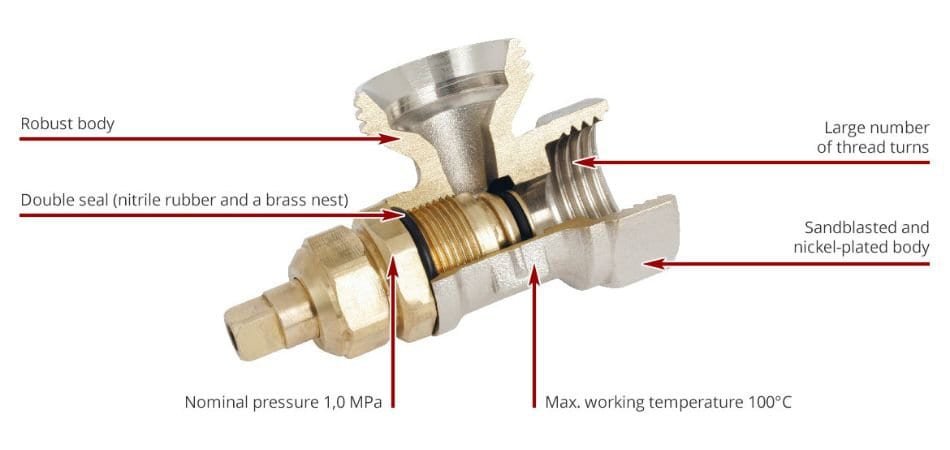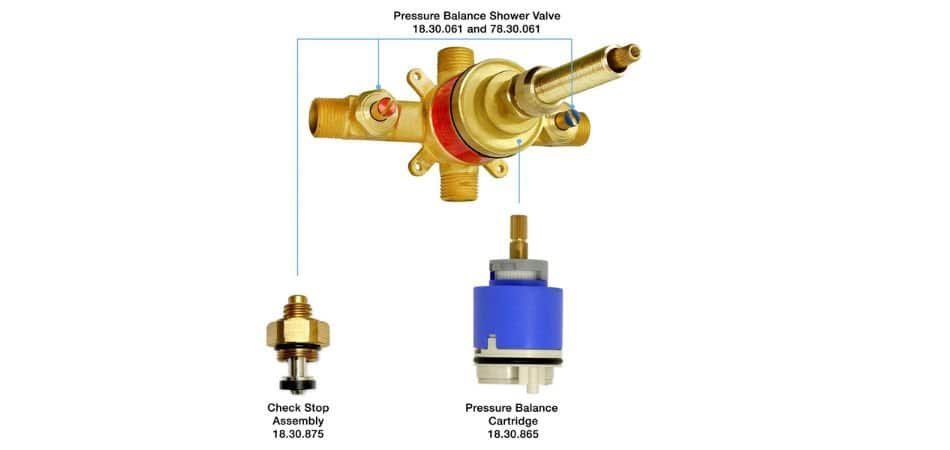Planning to switch your shower valve? Then you must decide which would be a better option: a thermostatic or pressure valve. Here we will discuss in detail some differences between these two major types of valves making it an easier option to select. Here, we have compared two primary types of valves, thermostatic valves, and pressure balance valves, their pricing, advantages/disadvantages, and which would be a better option and why.
All About Thermostatic Valves and Pressure Balance Valves:

A thermostatic valve, as its name suggests, is linked to temperature and controls temperature using a temperature sensor. It adjusts the water flow temperature to regulate any desired or set temperature. A thermostatic valve matches the required temperature by mixing hot and cold water.
While explaining technically, it maintains the temperature by continuously adjusting the cold and hot water in case of fluctuating temperatures.
On the other hand, a pressure balance valve simply controls the ratio of cold and hot water. A pressure balance shower valve has just one handle that controls both the temperature and the measurement. This valve also has a dial that shows the stopping point for the handle to control hot or cold water.
Raw Materials Comparison

Materials that make up a thermostatic valve are brass, making the valve’s body, and plastic for the head of the thermostatic valve. A pressure balance is comprised of different materials controlling different valve functions.
For e.g., brass is used in the main body of the valve, rubber or silicon is used for sealing any gaps, plastic or polymer is used in handles, and stainless steel is used in springs or other parts.
Size Comparison of Thermostatic and Pressure Balance Valve
Thermostatic valve sizes may be different depending on their uses. They are usually made to fit inside plumbing fixtures of 1/2, ¾, or 1-inch sizes.
Commonly used thermostatic valves are 4.7 to 7.9 inches long, with a width and depth of 2 to 4 inches.
Pressure balance valves also can be of different sizes depending on their application and design. For residential uses, they are also sized to fit inside the standard pipe sizes that are ½ or ¾ inch. Their overall dimensions are 4 to 6 inches long and 2 to 4 inches deep.
Working Principles of Thermostatic and Pressure Balance Valves
A thermostatic valve relies on a control element, which is its thermal cartridge. Its working principle is the expansion of materials when exposed to high temperatures.
The working of a pressure balance valve is based on the sensitivity of a piston located inside the valve that detects any change in pressure of hot or cold water, and as a result, it maintains balanced pressure. When one supply line drops pressure, the valve matches the pressure in the other line by reducing or increasing it.

Installation Differences between the Two Valves
The installation steps are the same whether you are working with thermostatic valves or pressure balance valves, except for some factors that should be considered:
- Complexity is a factor in thermostatic valve installation due to its additional components, whereas pressure balance valves are simple to install.
- Due to their complex installation, thermostatic valves are expensive both in terms of cost and installation labor, whereas the simplicity of installation in pressure valves makes them a budget-friendly option.
- Precision is also crucial when installing thermostatic valves due to their accurate temperature control and precise calibration, whereas no such precision is required when installing pressure balance valves.
Common Installation of Valves (An Easy Step-by-Step Guide):

You can easily install a thermostatic or a pressure balance valve by following these steps:
1. Selection of Valve
When you choose to install your valve, ensure it matches the size of the pipe where you are installing it. A correctly matched valve will work perfectly.
2. Stop the Water Supply:
After selecting the correct valve, your first step will be turning off the water supply to drain any remaining water in the pipes to ensure a dry working area.
3. Cutting and Measurement:
Measure the pipes correctly and cut them using a pipe cutter. The measurements should be done exactly to avoid differences in sizes.
4. Fitting the Valve:
With the help of the instruction manual, the valves are fitted. Install the compression fittings or soldering adapters where the pipe ends.
5. Securing Connections:
After installation, secure and tighten the connection using the right tools.
Pro tip: A perfectly working valve depends on perfect and secure connections.
6. Test the Valve:
Switch on the water supply to check if there is any leak. In case of leakage, adjust the settings and connections.
Pro Tip: Use a Teflon tape to avoid leaky spaces.
7. Finalize the Valve Connection:
After checking the leaks, finalize the connection by adding insulating pipes if needed. This is the final step. After ensuring your valve works perfectly, add any previously removed fixtures.
Pressure Balance Valve

What happens if your valve is on and you turn on the water supply to your washing machine or flush the toilet?
In this case, some of your cold water will pass to that other water supply that you have recently turned on, and the pressure balance valve will sense the changed ratio of hot water to that of cold water so it will immediately reduce the supply of hot water and makes that ratio same.
One problem with this is that, in this case, the pressure valve does not necessarily pay attention to the temperature, it means that if you turn the handle all the way to hot, the water that comes out of the shower will be as hot as the water heater can get and it might be higher than the thermostat that you set.
Application Differences:
Due to their mechanism and working differences, these two valves serve their applications differently. Due to this, you can easily pick between the two valves.
Thermostatic valves
- Thermostatic valves are used preferably due to their safety factor, which is precise temperature control to avoid scalding in different hospitals and nursing homes.
- They are used in luxury showers and high-end bathrooms due to their comfortable and smooth experience.
Pressure balance valves
- Pressure balance valves are commonly used in budget-dependent projects due to their affordability in installation.
- They are also widely used in residential bathrooms with older plumbing systems.
- Pressure balance valves are also used to measure the reliability of continual pressure changes.
You can select the best valve between the thermostatic and pressure balance valves according to your preferences and requirements.
A Broader Perspective and Comparison (which one should you choose)?
Pressure balance valves:
- People might go for a pressure balance valve due to its cost-effectiveness. People might think that they are getting moderate comfort and basic protection. However, the downside of using this type of valve is that there is no pressure control, which keeps it behind when it comes to smart protection.
- They are easier to install and maintain due to their simplicity in design and operation.
- Pressure balance valves are readily available in local markets compared to thermostatic valves.
Thermostatic valves:
- Thermostatic valves are safer for households due to their precision in controlling temperatures.
- Thermostatic valves are convenient and comfortable because there is no need for readjusting them in case of fluctuating temperatures.
- The price might cost you more initially, but this valve is quite smart when it comes to water conservation.
- The reason is you just need to move the handle that controls the volume of the water without changing the temperature, resulting in more water conservation while shampooing or shaving.
Thermostatic valves are available more readily now on multiple online plumbing solution websites like https://plumberstar.com/

Words from the Most Reliable Plumbers In Favor of Thermostatic Valves
Some of the most reliable plumbers and plumbing solution websites suggest you go for thermostatic valves in showers for some very obvious reasons;
- They provide precise and accurate temperatures for your shower, which are comfortable for you and your family and will stay like that for years until you change it yourself.
- In all the thermostatic valves, a maximum temperature limit is very safe and reliable for you and your family to use.
- It keeps your comfortable temperature undisturbed by other water-utilizing sources, like your toilet.
How to Get Good Valve Suppliers and Service:
Finding good and reliable suppliers is a detailed process that includes several steps and factors to keep in mind. However, if you follow a step-by-step method, it won’t be any more daunting for you.
Identify Your Need:
The first step in this journey is to choose the valve that suits your needs and requirements. This will prove to be a major task.
Research About Your Product:
After keeping a specific product in your mind, research about it. You can do it online, too. It will be detailed research about your product’s raw materials and picking any specific type in case of a number of varieties.
Find Reliable Suppliers
Finding a good supplier also requires a lot of research through different websites and online surveys. It also includes checking their credentials, product feedback, and testimonials.
Also, check whether they have your specific product and what they offer in that category.
Customer Service:
After much hard work and research, now it’s time to contact them to check their customer service skills and responsiveness. You can ask a few questions about their business and products and how they can satisfy your confusion.
Compare Pricing and Packages:
After obtaining all the necessary details from a supplier, repeat this process for several suppliers. Compare their pricing and packages and select the one that best suits your needs.
Concluding Remarks
There isn’t a single formula guide about which is better: a thermostatic or pressure balance valve. It mainly depends on your needs and preferences based on specific requirements. Both are equally useful in terms of working and effectiveness; however, a thermostatic valve is preferred due to its safety features if there are elderly members and children in your family.
On the other hand, the pressure balance valve proves to be a more affordable and cost-effective option, so when you are giving your home some final touches, budget is one of the greatest factors. At this point, you might make some choices that are budget-friendly. Please feel free to contact us if you have any more questions or requirements.
